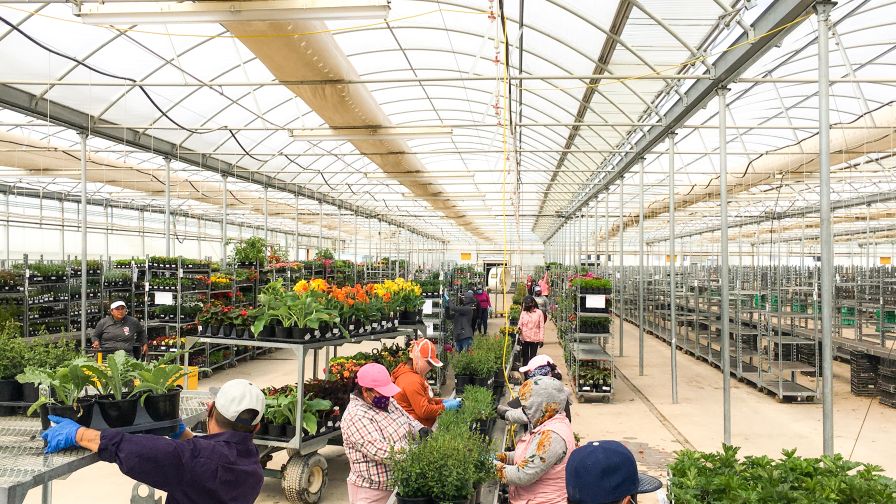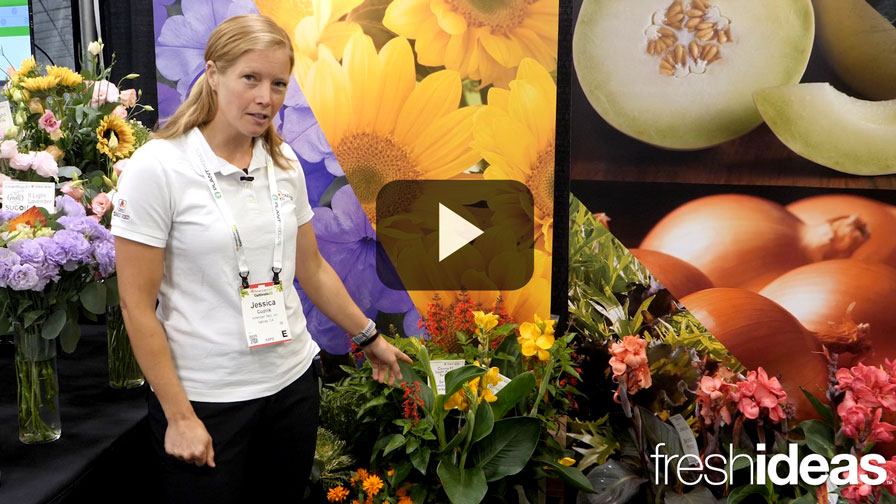How the Top 100 Growers Are Navigating Horticulture Supply Chain Issues
 When you’re dealing with hundreds of thousands of square feet of controlled-environment production, any wrinkle in the supply chain can have major effects. As part of Greenhouse Grower’s continuing coverage of supply chain concerns in horticulture, we reached out to members of our Top 100 Growers community of ornamentals operations and asked them how these issues are affecting their planning for 2022 and beyond. Here’s what some of them had to say.
When you’re dealing with hundreds of thousands of square feet of controlled-environment production, any wrinkle in the supply chain can have major effects. As part of Greenhouse Grower’s continuing coverage of supply chain concerns in horticulture, we reached out to members of our Top 100 Growers community of ornamentals operations and asked them how these issues are affecting their planning for 2022 and beyond. Here’s what some of them had to say.
Q1: How are supply chain issues affecting your ability to plan for next year?
“Due to supply chain delays in acquiring materials, we are ordering supplies much earlier this year than in the past. Even with this strategy, we are concerned that the materials for production will arrive on time. In addition to the shipping delays, we are seeing price increases of anywhere from 6% to 25%. Plastic material prices seem to be increasing the most. We ordered our peat moss for summer of 2022 in June of 2021 and have received some of it already. This means we will have to pay for materials earlier than expected and might increase our draw on the line of credit. I think we will receive the materials we need as long as we order it well in advance.” — William Swanekamp, President, Kube-Pak, Allentown, NJ
“It has been and is making it rather challenging. First, it has been a challenge pricing our product to our customers, as the prices of our raw materials have changed dramatically and continue to change almost daily. Second, we most certainly can’t wait as long as we are accustomed to when placing our raw material orders. Our supply chain is filling up much faster than usual and we are having to really push our customers and doing our in- house analysis based on store fill quantities at a pace that can allow for errors. However, we all know that this is going to be an issue for the next season. We may have to adjust some and not get the exact pot, tag, or plant material that we originally wanted, but get a little creative and still make everything happen on time for our customers.” — Ed Van Hoven, President, American Color, Orange, VA
“To be honest, it’s not a pretty picture. Demand for our products is at an all-time high. We rely on our global suppliers for timely services and shorter lead times for the goods and services we purchase from them. Our biggest pain point regarding the supply chain issues that is happening right now is the lack of predictability. We’re not only seeing a doubling of transportation costs, but also congestion at the factories, with either a lack of staffing or the re-introduction of COVID-19. This all impacts our lead times. and it’s resulting in a delay in our planning horizon to 24 months, and sometimes even longer. We have to continue to look out further on the horizon because we don’t know when the supply chain issues will ease up.” — Bill Antonace, Director of Supply Chain, Green Circle Growers, Oberlin, OH
“The supply chain issues are real, and to mitigate this, our procurement team is being diligent about putting in extra work on the front end to ensure we order early and accurately. There is no room for error. We are also using up some cash flow and bringing in items ahead of schedule to build a buffer for any unforeseen supply chain issues.” — Bryan Young, Young’s Plant Farm, Auburn, AL
“Supply chain issues are causing a lot of issues. We are having trouble getting almost everything, and the pricing is significantly increased, which will lead to higher prices for our product. In some cases, I am buying plastics with no guarantee on pricing, or the supplier has let us know the original quote is no longer any good. Pricing will be determined at time of ship. How am I supposed to figure out my costing for the next season” — George Lucas, Owner, Lucas Greenhouses, Monroeville, NJ
“At this point, we are finding large changes necessary to how we look at upcoming needs. First, requesting plastic deliveries four to six weeks prior to need is no longer safe. We are finding that even requesting deliveries 10 to 12 weeks ahead of need is not necessarily ensuring product is here on time. Overseas vendors are running into multiple layers of transportation issues, often starting at the beginning of their manufacturing process and not getting their raw materials on time, or in labor shortages and not being able to keep up with manufacturing demands. Domestic sources are seeing similar issues and are also struggling to make requested delivery dates. Most plastic suppliers are now telling us eight to nine months for new orders, which is forcing us to lock in plans for that nine months, plus the 10 to 12 weeks of buffer, meaning long-term planning and getting sourcing completed earlier is more important than ever. Where we are not that far ahead, we are beginning to find we need to make compromises, or without, on some products.” — Scott Crownover, President and CEO, Skagit Horticulture, Mt. Vernon, WA
“The supply chain is making us hesitant to do pricing, as we are not getting guaranteed pricing on any of our inputs. We are also having to order so early we are not sure if we are going to hit our needed numbers or not, so like everyone else we are ordering over, which we know will be more than we need, at probably a higher price than we expected. Storage is another issue; we are having to store two to three times the amount of product four to five months longer than we would any other year. Storage is money. We are making purchases that will go on this year’s books, but against next year’s revenue. We are also having to spend time shopping around for items we normally were locked into suppliers for.” — Jeff Back, Director of Greenhouse Operations, Four Star Greenhouse, Carleton, MI
“Yes, we are experiencing supply chain issues across the board. Almost all suppliers are having issues with delivery, price increases, and delays. I would say that soil ingredients like coir and peat are being impacted the worst because we just can’t get them delivered in a timely manner. Containers and plastic are experiencing double-digit price increases, plus additional delivery expenses. I anticipate that there will be shortages of seed and cuttings this spring due to significant increases in demand along with delivery issues. We are dealing with these challenges by ordering as early as possible from our suppliers and increasing our selling prices. In addition, we are being as flexible as possible, allowing subs and back orders where we would normally not.” — Lisa Ambrosio, Manager, Wenke Greenhouses, Kalamazoo, MI
Q2: How are these issues affecting your long-term planning (expansion, new tech investments, etc.)?
“Expansion of the business through construction is also a concern. Many suppliers are pushing construction material deliveries out to the summer of 2022. Again, the need to plan well in advance is critical.” — William Swanekamp
“These current issues with the supply chain are not affecting our long-term planning at all. We simply need to allow for enough time to make these decisions and not wait until the last minute.” — Ed Van Hoven
“The issues are causing us to accelerate strategic plans at a rapid pace. We’re in the midst of implementing a robust planning structure for the future, and our goal is to plan and not react right now, with a focus on not only infrastructure, but also systems. Our demand and supply plans must be more accurate than ever before, and when you’re planning out that far, it’s easy for errors to occur. We forecast for that error rate and increase our inventory of buffer stocks to enable reaction and flexibility. Additionally, we have to consider space concerns. This methodology positions inventories high, and turns low. And the longer the inventory sits, it’s more susceptible to damage and inaccurate inventory counts.” — Mike Jewell, Senior Manager of Procurement, Green Circle Growers
“For long-term planning, we are making decisions almost a year sooner than we normally do. For example, we have already secured tractor trailer orders for 2023 projected needs.” — Bryan Young
“I have a five-year plan for expansion that is now on hold. I was going to build about 500,000 square feet of greenhouse space this fall, but am waiting to see if pricing and availability will get back to normal (whatever that is now). We are going to go after some smaller projects and other maintenance-type projects for the near future to see if things calm down and availability of goods becomes more readily available. I’m tired of hearing about 16 weeks out, 24 weeks out, or ‘well, maybe mid 2022 we can get that to you.’” — George Lucas
“Getting ahead of these issues has had us looking for any means possible to reduce/re-use. We have invested in tray washers/disinfectors in order to re-use more of our plastics, eliminating some of our purchase demand for new material in the future. We have taken steps to order everything possible from the West Coast suppliers, even if it means dropping/changing to reduce our freight spend and risk. In past years, we have installed an Autostix machine to reduce labor needed internally, and from those gains we continue to move more and more towards producing everything from seeds/unrooted cuttings/tissue culture ourselves instead of having to order rooted liners and fight the freight cost and trucking shortages.” — Scott Crownover
“We are stuck between having to plan way further ahead to resource expansion materials, but yet have no idea of what market lies ahead. We would rather plan for a quick reaction to the market, but resources will not allow this. Uncertainty is affecting all expansion idea; the only thing for certain is labor will not get cheaper or be more available, so automation is a must, but a price, and at a time frame, that we can still automate for next season. With so many places going out of business or wanting to sell, is now the time to buy an existing business, or will the future support this?” — Jeff Back
“This is a good reminder about the importance of having positive, long-term relationships with our vendors. The good news is, these supply chain shortages are not impacting our long-term planning for expansion. I anticipate that the supply chain will become more normal in a year. As always, we will learn to adjust as needed.” — Lisa Ambrosio










